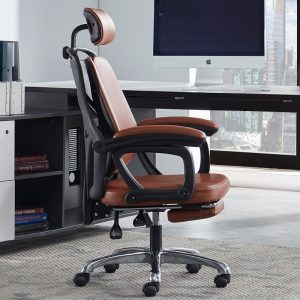Introduction: Ergonomic chairs are more than just comfortable seating; they are carefully designed to support the body’s natural alignment, promoting health and productivity. In this blog, we will delve into the science behind ergonomic chairs and how their design impacts physical well-being and work performance.
- Biomechanics of Ergonomic Design: Ergonomic chairs are built based on principles of biomechanics, considering how the body moves and interacts with the chair. Adjustable features like seat height, lumbar support, and armrests accommodate various body types and ensure proper alignment.
- Spinal Support and Posture: One of the primary focuses of ergonomic chair design is maintaining a healthy posture. The curvature of the backrest and lumbar support offer crucial spinal support, reducing the risk of back pain and related issues caused by poor posture.
- Pressure Distribution and Comfort: Ergonomic chairs distribute body weight evenly, reducing pressure points and discomfort. Ample cushioning and breathable materials contribute to prolonged comfort during extended sitting periods.
- Promoting Blood Circulation: Ergonomic chairs often feature a waterfall seat edge design, which prevents compression of blood vessels in the back of the thighs. Improved blood circulation prevents leg numbness and contributes to better focus and productivity.
- Reducing Musculoskeletal Disorders (MSDs): By promoting proper posture and providing support to key areas of the body, ergonomic chairs can help reduce the risk of Musculoskeletal Disorders (MSDs) commonly associated with extended periods of sitting.
- Enhanced Focus and Concentration: Comfortable and supportive ergonomic chairs enable users to focus on their tasks without distractions caused by discomfort. Maintaining physical well-being leads to improved focus and concentration, enhancing overall productivity.
- Customization for Individual Needs: Ergonomic chairs offer a high level of customization, allowing users to adjust the chair’s settings to suit their unique body shapes and preferences. Personalized comfort fosters a positive work environment and increased productivity.
Conclusion: The science behind ergonomic chair design is rooted in promoting physical well-being and enhancing productivity. By understanding the biomechanics of the human body and implementing features that support natural alignment, ergonomic chairs play a crucial role in creating a healthy and productive workspace.













